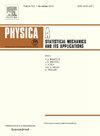Hartree–Fock approximation for bosons with symmetry-adapted variational wave functions
IF 2.8
3区 物理与天体物理
Q2 PHYSICS, MULTIDISCIPLINARY
Physica A: Statistical Mechanics and its Applications
Pub Date : 2025-02-20
DOI:10.1016/j.physa.2025.130449
引用次数: 0
Abstract
The Hartree–Fock approximation for bosons employs variational wave functions that are a combination of permanents. These are bosonic counterpart of the fermionic Slater determinants, but with the significant distinction that the single-particle orbitals used to construct a permanent can be arbitrary and do not need to be orthogonal to each other. Typically, the variational wave function may break the symmetry of the Hamiltonian, resulting in qualitative and quantitative errors in physical observables. A straightforward method to restore symmetry is projection after variation, where we project the variational wave function onto the desired symmetry sector. However, a more effective strategy is variation after projection, which involves first creating a symmetry-adapted variational wave function and then optimizing its parameters. We have devised a scheme to realize this strategy and have tested it on various models with symmetry groups ranging from , , to . In all the models and symmetry sectors studied, the variational wave function accurately estimates not only the energy of the lowest eigenstate but also the single-particle correlation function, as it approximate the target eigenstate very well on the wave function level. We have applied this method to study few-body bound states, superfluid fraction, and Yrast lines of some Bose–Hubbard models. This approach should be valuable for studying few-body or mesoscopic bosonic systems.
求助全文
约1分钟内获得全文
求助全文
来源期刊
CiteScore
7.20
自引率
9.10%
发文量
852
审稿时长
6.6 months
期刊介绍:
Physica A: Statistical Mechanics and its Applications
Recognized by the European Physical Society
Physica A publishes research in the field of statistical mechanics and its applications.
Statistical mechanics sets out to explain the behaviour of macroscopic systems by studying the statistical properties of their microscopic constituents.
Applications of the techniques of statistical mechanics are widespread, and include: applications to physical systems such as solids, liquids and gases; applications to chemical and biological systems (colloids, interfaces, complex fluids, polymers and biopolymers, cell physics); and other interdisciplinary applications to for instance biological, economical and sociological systems.

 求助内容:
求助内容: 应助结果提醒方式:
应助结果提醒方式:


